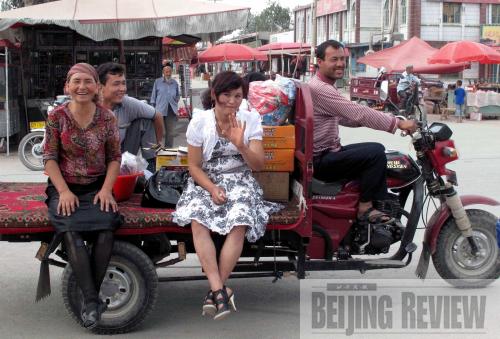By Li Peilin
The author is Director of the Institute of Sociology, Chinese Academy of Social Sciences, and Chairman of the Chinese Association of Sociology
 |
|
LEARNING SKILLS: A pastry cook (far left) teaches laid-off workers how to make crescent-shaped dumplings. The program is part of government efforts to combat unemployment (SUN SHEN)
|
Since the founding of the People's Republic of China in 1949, Chinese society has undergone a dramatic transformation, particularly in the 31 years since the country adopted the reform and opening-up policy in late 1978. China has gradually shifted from a predominantly agrarian country to an emerging industrial nation with an ever-increasing level of urbanization. Having received classification from the World Bank as a lower middle-income country, after previously being listed as a low-income country, it is marching toward a more modern society.
China's population structure has gone through a historic transition. It now features a low birth rate, low death rate, and low growth rate, with average life expectancy reaching the level of a moderately developed country. China, once a country suffering from overpopulation, has become a nation with rich human resources. It has lifted hundreds of millions of Chinese out of poverty, making significant contributions to the global poverty alleviation effort. It has also created a social security net, covering not only urban residents, but also those in rural areas who have never before had social security protection.
Government action
In the early years of the People's Republic of China, the Chinese people lived in complete destitution, as the country was ravaged by the scourge of war. Under the leadership of the Communist Party of China (CPC), China swiftly resumed economic development, stabilized consumer prices and improved people's livelihoods. With steady economic growth, social development made great strides. Even before China adopted the reform and opening-up policy in 1978, people's living standards had been improving steadily, as the country experienced relatively full employment. The government put in place social security, education and healthcare systems in line with the progress of industrialization.
 |
|
CHEERFUL EVENT: Residents in Kuche County, Xinjiang Uygur Autonomous Region, prepare to go shopping during Bazaar Day (SHEN QIAO)
|
In spite of these achievements, China experienced many setbacks in social development due to the chaos caused by the "cultural revolution" (1966-76). After it adopted the reform and opening-up policy, China shifted its top priority from class struggle to economic development. The fast economic growth since then has propelled an unprecedented level of development in social undertakings.
To date, the Chinese Government has adopted a series of policies guiding China's social development:
Its population policies encourage a low birth rate and the improvement of population quality, while seeking to perfect the overall population structure in an effort to address the aging of its population. Stimulating the rational movement of human resources, as well as promoting the all-around development of the Chinese people, is also a primary concern.
In its employment policies, China adheres to a proactive approach that focuses on expanding employment by building a unified labor market in both rural and urban areas. Its employment service system encourages the employment of the newly added work force in urban areas and rural surplus laborers, and the reemployment of laid-off workers.